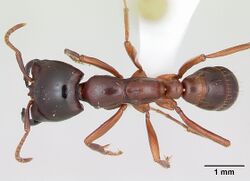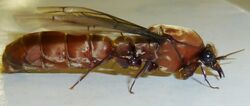Biology:Dorylus
| Dorylus | |
|---|---|

| |
| Dorylus gribodoi | |
| Scientific classification | |
| Domain: | Eukaryota |
| Kingdom: | Animalia |
| Phylum: | Arthropoda |
| Class: | Insecta |
| Order: | Hymenoptera |
| Family: | Formicidae Leach, 1815 |
| Subfamily: | Dorylinae Leach, 1815 |
| Genus: | Dorylus Fabricius, 1793 |
| Type species | |
| Vespa helvola | |
| Diversity[1] | |
| 61 species | |
| Synonyms | |
|
Cosmaecetes Spinola, 1851 | |
Dorylus, also known as driver ants, safari ants, or siafu, is a large genus of army ants found primarily in central and east Africa, although the range also extends to southern Africa and tropical Asia. The term siafu is a loanword from Swahili,[2] and is one of numerous similar words from regional Bantu languages used by indigenous peoples to describe various species of these ants. Unlike the New World members of the former subfamily Ecitoninae (now Dorylinae), members of this genus form temporary subterranean bivouacs in underground cavities which they excavate and inhabit - either for a few days or up to three months. Also unlike some New World army ants, driver ants are not specialized predators of other species of ant, instead being more generalistic with a diet consisting of a diversity of arthropods. Colonies are enormous compared to other army ants and can contain over 20 million individuals. As with their American counterparts, workers exhibit caste polymorphism with the soldiers having particularly large heads that power their scissor-like mandibles. They are capable of stinging, but very rarely do so, relying instead on their powerful shearing jaws.[3] Driver ant queens are the largest living ants known, with the largest measuring between 40 - 63 millimeters (1.5 - 2.4 inches) in total body length depending on their physiological condition.[4]
Life cycle
Seasonally, when food supplies become short, they leave the hill and form marching columns of up to 50,000,000 ants, which are considered a menace to people, though they can be easily avoided; a column can only travel about 20 metres in an hour. It is for those unable to move, or when the columns pass through homes, that there is the greatest risk.[5] Their presence is, conversely, beneficial to certain human communities, such as the Maasai, as they perform a pest prevention service in farming communities, consuming the majority of other crop-pests, from insects to large rats.[6] For example, driver ants prey on larvae of the African sugarcane borer, a pest moth in sub-Saharan Africa.
The characteristic long columns of ants will fiercely defend themselves against anything that attacks them.[3] Columns are arranged with the smaller ants being flanked by the larger soldier ants. These instinctively take up positions as sentries, and set a perimeter corridor through which the smaller ants can run safely. Their bite is severely painful, each soldier leaving two puncture wounds when removed. Removal is difficult, however, as their jaws are extremely strong, and one can pull a soldier ant in two without it releasing its hold. Large numbers of ants can kill small or immobilized animals and strip them to husks. A large part of their diet is earthworms. All Dorylus species are blind, and, like most varieties of ants, communicate primarily through pheromones.[3]
In the mating season, alates (winged drones, queens of driver-ant species do not grow wings) are formed. The drones are larger than the soldiers and the queens are even larger. Driver ants do not perform a nuptial flight, but mate on the ground and the queens go off to establish new colonies. As with most ants, workers and soldiers are sterile females, and so do not reproduce.[3]
Male driver ants, sometimes known as "sausage flies" (a term also applied to males of New World dorylines) due to their bloated, sausage-like abdomens, are among the largest ant morphs and were originally believed to be members of a different species. Males leave the colony soon after hatching but are drawn to the scent trail left by a column of siafu once they reach sexual maturity. When a colony of driver ants encounters a male, they tear his wings off and carry him back to the nest to be mated with a recently hatched queen. As in the majority of ant species, males die shortly afterward.[3] Driver ant queens exhibit polyandry; young queens from some species with large colony sizes must mate with 10–20 males before they have gathered enough sperm for their reproductive lives.[7] Once the queen is ready, roughly half of the workers in the colony will leave with her to found a new colony.[8] Driver ant queens are the largest ants on Earth and have the greatest egg-laying capacity among insects, laying several million eggs each month.[9]
Such is the strength of the ant's jaws that, in East Africa, they are used as natural emergency sutures. Various East African indigenous tribal peoples (e.g. Maasai moran), when suffering from a gash in the bush, will use the soldiers to stitch the wound by getting the ants to bite on both sides of the gash, then breaking off the body. This use of ants as makeshift surgical staples creates a seal that can hold for days at a time, and the procedure can be repeated, if necessary, allowing natural healing to commence.[10]
Several species in this genus carry out raids on termitaria, paralyzing or killing termites and carting them back to the nest.[11]
Colonies of driver-ant species have only one queen.[12] When she dies, the surviving workers may try to join another colony, but in other cases, when two colonies of the same driver-ant species meet, they usually change the marching directions to avoid conflicts.[citation needed]
Species
- D. acutus Santschi, 1937
- D. aethiopicus Emery, 1895
- D. affinis Shuckard, 1840
- D. agressor Santschi, 1923
- D. alluaudi Santschi, 1914
- D. atratus Smith, 1859
- D. atriceps Shuckard, 1840
- D. attenuatus Shuckard, 1840
- D. bequaerti Forel, 1913
- D. bishyiganus (Boven, 1972)
- D. braunsi Emery, 1895
- D. brevipennis Emery, 1895
- D. brevis Santschi, 1919
- D. buyssoni Santschi, 1910
- D. congolensis Santschi, 1910
- D. conradti Emery, 1895
- D. depilis Emery, 1895
- D. diadema Gerstaecker, 1859
- D. distinctus Santschi, 1910
- D. ductor Santschi, 1939
- D. emeryi Mayr, 1896
- D. erraticus (Smith, 1865)
- D. faurei Arnold, 1946
- D. fimbriatus (Shuckard, 1840)
- D. fulvus (Westwood, 1839)
- D. funereus Emery, 1895
- D. furcatus (Gerstaecker, 1872)
- D. fuscipennis (Emery, 1892)
- D. gaudens Santschi, 1919
- D. ghanensis Boven, 1975
- D. gribodoi Emery, 1892 – includes D. gerstaeckeri Emery, 1895
- D. helvolus (Linnaeus, 1764)
- D. katanensis Stitz, 1911
- D. kohli Wasmann, 1904
- D. labiatus Shuckard, 1840
- D. laevigatus (Smith, 1857)
- Dorylus lamottei (= D. gribodoi) Bernard, 1953
- D. leo Santschi, 1919
- D. mandibularis Mayr, 1896
- D. mayri Santschi, 1912
- D. moestus Emery, 1895
- D. molestus Wheeler, 1922
- D. montanus Santschi, 1910
- D. niarembensis (Boven, 1972)
- D. nigricans Illiger, 1802
- D. ocellatus (Stitz, 1910)
- D. orientalis Westwood, 1835
- D. politus Emery, 1901
- D. rufescens Santschi, 1915
- D. savagei Emery, 1895
- D. schoutedeni Santschi, 1923
- D. spininodis Emery, 1901
- D. stadelmanni Emery, 1895
- D. stanleyi Forel, 1909
- D. staudingeri Emery, 1895
- D. striatidens Santschi, 1910
- D. termitarius Wasmann, 1911
- D. titan Santschi, 1923
- D. vishnui Wheeler, 1913
- D. westwoodii (Shuckard, 1840)
- D. wilverthi Emery, 1899
See also
- Army ant
References
- ↑ Bolton, B. (2014). "Dorylus". AntCat. http://antcat.org/catalog/429483.
- ↑ Swahili translation
- ↑ 3.0 3.1 3.2 3.3 3.4 Hölldobler, Bert; Wilson, Edward O. (1990). The Ants. Belknap Press of Harvard University Press. ISBN 0-674-04075-9.
- ↑ Kronauer, Daniel (2020). Army Ants Nature's Ultimate Social Hunters. Cambridge, Massachusetts: Harvard University Press. pp. 237. ISBN 978-0-674-24155-8.
- ↑ "NOVA - Master of the Killer Ants - PBS". https://www.pbs.org/wgbh/nova/ants/.
- ↑ Hastings, H.** Conling, D.E., Graham, D.Y.* & (1988-03-01). "Notes on the natural host surveys and laboratory rearing of Goniozus natalensis Gordh (Hymenoptera: Bethylidae), a parasitoid of Eldana saccharina Walker (Lepidoptera: Pyralidae) larvae from Cyperus papyrus L. in Southern Africa"[yes|permanent dead link|dead link}}](PDF). Journal of the Entomological Society of Southern Africa
- ↑ Kronauer, Daniel J.C.; Johnson, Robert A.; Boomsma, Jacobus J. (February 23, 2007). "The Evolution of Multiple Mating in Army Ants". Evolution 61 (2): 413–422. doi:10.1111/j.1558-5646.2007.00040.x. PMID 17348950. "The evolution of mating systems in eusocial Hymenoptera is constrained because females mate only during a brief period early in life, whereas inseminated queens and their stored sperm may live for decades…We show that queens of Neivamyrmex and Aenictus mate with the same high numbers of males (usually ca. 10–20) as do queens of army ant species with very large colony sizes…The species of Dorylus (Anomma) and Eciton where multiple queen mating has been documented (Kronauer 2004, 2006a, 2006b; Denny et al. 2004) have extreme degrees of worker caste polymorphism and larger colonies than almost any other social insect…".
- ↑ Kronauer, Daniel J.C. (September 11, 2009). "Recent advances in army ant biology (Hymenoptera: Formicidae)". Myrmecological News 12: 51–65. https://myrmecologicalnews.org/cms/index.php?option=com_download&view=download&filename=volume12/mn12_51-65_printable.pdf&format=raw. Retrieved 2023-07-05. "The permanent lack of wings in army ant queens has one important corollary: they do not go on mating flights. Instead, young army ant queens mate inside their natal colony with foreign males that disperse on the wing…The reproductive colony undergoes fission during which the worker force splits into two roughly equal parts…".
- ↑ Kronauer, Daniel J.C.; Johnson, Robert A.; Boomsma, Jacobus J. (February 23, 2007). "The Evolution of Multiple Mating in Army Ants". Evolution 61 (2): 413–422. doi:10.1111/j.1558-5646.2007.00040.x. PMID 17348950. "Being the largest ants on Earth, African Dorylus (Anomma) queens also hold the world record in reproductive potential among the insects, with an egg-laying capacity of several millions per month…".
- ↑ "From Ants to Staples: History and Ideas Concerning Suturing Techniques". https://www.researchgate.net/publication/233766133.
- ↑ Biotropics
- ↑ Boswell, Grame P.; Franks, Nigel R.; Britton, Nicholas (19 March 2001). "Arms races and the evolution of big fierce societies". Proceedings of the Royal Society B: Biological Sciences 268 (1477): 1723–1730. doi:10.1098/rspb.2001.1671. PMID 11506686. PMC 1088800. https://repository.si.edu/bitstream/handle/10088/11784/stri_Boswell_Franks_and_Britton.pdf?sequence=1&isAllowed=y. Retrieved 2023-07-05. "Here we consider the largest single-queen insect societies, those of the Old World army ant Dorylus, single colonies of which can have 20 million workers.".
External links
Wikidata ☰ Q1352647 entry
 |






